Spitfire Audio: Hans Zimmer Strings Review – Epic Proportions
The latest library from Spitfire Audio brings us a string section of epic proportions with help from one of the biggest names in film. Dave Gale gets cinematic… Price £699 Contact Spitfire Audio Hans Zimmer Strings key features: 344 String players Violin, Viola, Cello and Double Bass sections Myriad of Mic Positions Huge range of […]

The latest library from Spitfire Audio brings us a string section of epic proportions with help from one of the biggest names in film. Dave Gale gets cinematic…
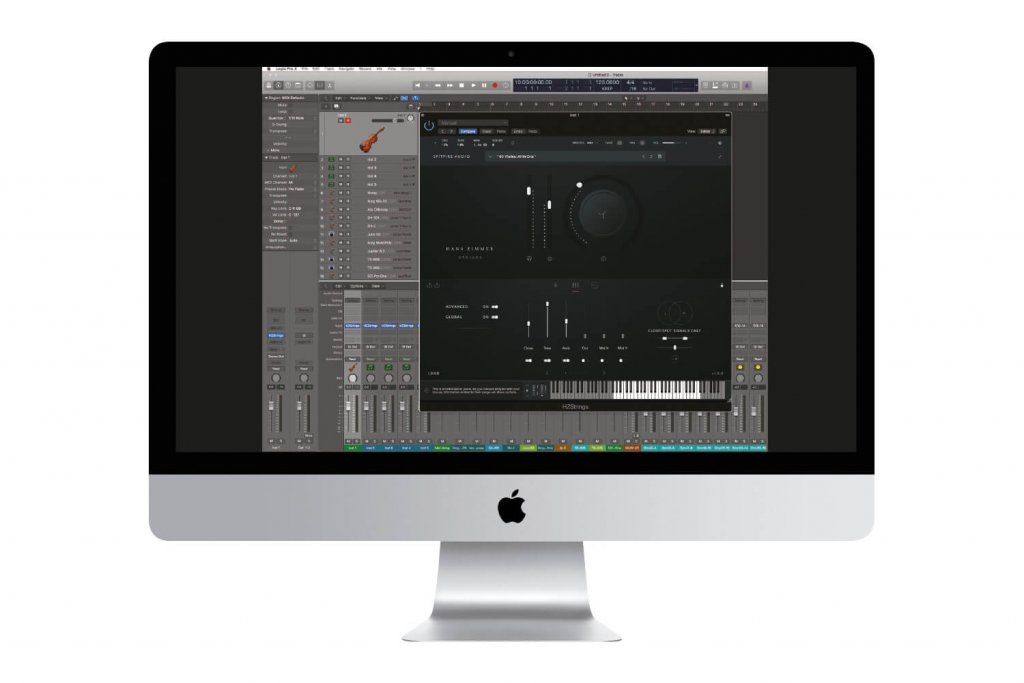

Price £699
Contact Spitfire Audio
Hans Zimmer Strings key features:
- 344 String players
- Violin, Viola, Cello and Double Bass sections
- Myriad of Mic Positions
- Huge range of dynamics
- 183Gb of Disk space required (200Gb during install)
- New Spitfire Virtual Instrument/Interface (VST2, VST3, AU & AAX)
- Sessions recorded at Air Studios
Known for his innovative approach to contemporary scoring, much of Hans Zimmer’s work embraces technology, combining the use of synthesisers and sampling alongside live players, in order to achieve his signature soundscapes. It’s with this in mind that sampling supremos Spitfire Audio have teamed up with Hans to offer a new package that’s on a truly grand scale.
New to GUI
Before we can get stuck in, we have to go through the download process – and that may take a while… With 183Gb to download, it took us a whole day for installation, although there is an option to purchase the library on a drive from Spitfire, so if you’re not blessed with the best download speed, this will certainly appeal.
Once installed, the first thing that you will notice is that this is not the usual Kontakt-based library – the format which Spitfire normally adopt – but a new bespoke plug-in which has been designed with the help of design and user experience agency, UsTwo.
The user interface opens as a single large window, but can be resized and minimised to expose the elements which are required by the user. In a change from the more usual Kontakt experience, the upper portion of the window offers two faders, which are default assigned to expression and dynamics, with an assignable rotary pot.
Clicking on this pot will allow selection of another controllable parameter, such as vibrato or reverb, with options dictated by the chosen sample. All of these elements will remain in play if you seek control via an external MIDI CC based device, whether the parameters are visible or not.
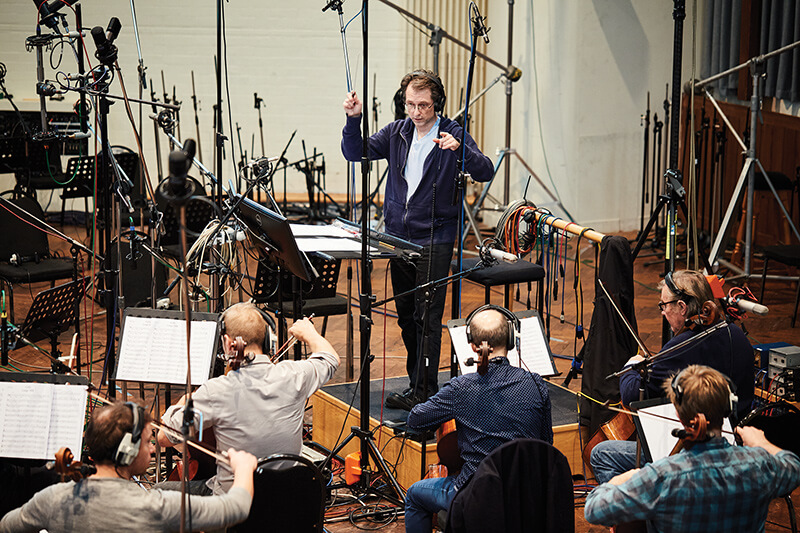
While this looks very elegant and clean, there is a sense that it wastes a lot of screen space, particularly when you factor in that there is a degree of repetition of parameter in the lower part of the window, which is dependent on your chosen viewing preferences. It’s almost as though the UI was designed in hardware and translated to software; there is a lovely elegance and simplicity, but while uncluttered, it does leave some dead space in the window.
Unlike other Kontakt-based libraries, HZ Strings is not multi-timbral, meaning that you will need to load a new instance of the plug-in for each instrument that you require. Being curious about the loading and system consequences that this might have, I performed a few tests against Spitfire’s Symphonic Strings, which firmly operates within the Kontakt construct.
RAM allocation is largely the same, with loading times performing well in HZ Strings, however this could rapidly change according to the number of microphone elements that are bought into play.
Exploring the ‘60 Cellos: All In One’ patch, while adding the close and ambient mics, the RAM allocation quickly jumped to just over 1GB, and without the ability to offload articulations, as you can do in Kontakt, the user would be forced to work with single articulation patches, which would in turn require the loading of more instances of the plug-in.
I found HZ Strings to be roughly twice as CPU hungry as its Kontakt counterpart, which could have consequences for the loading of multiple instances. In itself, the lack of multi-timbral operation might simply require a change in your usual work flow, but clearly the addition of further active plug-ins might reduce the number of tracks available on a given system.
Spitfire themselves, however, do stress that the intensive resource demands of Hans Zimmer Strings are being addressed and further updates will smooth out some, if not all, of these technical issues.
Epic by nature
It’s impossible to miss the biggest selling point of Hans Zimmer Strings, which is built on a string section which is not just sizeable, but enormous. Checking in at 344 string players – equivalent to five symphony orchestra string sections – sampling sessions were conducted on a section by section basis, using many of London’s finest players, in the prestigious main hall at Air Lyndhurst, which can accommodate large numbers, while offering unique placement of players, such as high up in the gallery.
The Violin and Cello sections offer the greatest mass, with 140 players in each section. It’s interesting to note that there is no distinction between Violin 1 and 2, as you might normally expect, purely because there is such a wide palette of player placements including Full section, Left, Centre, Right and Galleries. By choosing the appropriate sub-section, it would be possible to be more traditional with the stereoscopic placement.
The Violas are more streamlined, offering a mere 40 players located in central and wide placements, while the basses offer 24 players, located centrally. Within each section, the user will find a multitude of microphone positions, which extend from the usual Decca Tree and close mic placement, up to the large array of microphones which were scattered around the hall during the session. One of the more obscure is the ‘Bottle’ placement, where a microphone was placed inside a large water cooler bottle and sampled.
Grand hushed tones
Time to explore the timbral options by firstly choosing the instrument you require. This isn’t as simple as it might sound; starting with the Violin section, you’ll find a choice extending from the main section, consisting of 60 players, through to various sections which are set out in the stereo image, finished off by the Violins recorded high up in the Gallery.
Once your choice is made, articulation selection is made through the usual means of clicking in the lower part of the Plug-in window, or key-switching. The Cello section offers a similarly large number of options, being mirrored in size to the Violins.
The Violas and Double Basses offer less options, as the number of players is also less – but don’t go thinking it’s lacking, because there is still an awful lot of choice.
While any orchestral library user will know that you have to really work with a library to truly understand its capabilities, I was momentarily confused by a degree of inconsistency in the offered articulations.
A case in point, with the choice of either the Violin or Cello main 60 player sections, there are no regular Pizzicato articulations, but there is an aggressive Bartok Pizzicato. Looking through the various options, I did locate Pizzicato articulations elsewhere, but I am curious as to the rationale here.
Apart from arguably not having a common articulation where you want it, it’s confusing to find that a basic articulation such as this is not available with what many might see as the first/main patch, especially when there are many other articulations to choose from in the same patch, which could be regarded as less obvious. Given time we daresay that these unique nuances will be easier to understand.
Space and air
There is a large quota of elements at the quieter end of the dynamic spectrum. Spitfire have always had a passion for the Scandinavian school of orchestral sound exploration, as seen in some of their other libraries such as Albion V, but I was surprised to find so much of it here.
The Con Sord long notes are truly sublime, as are the Flautando and Sul Pont. Unlike previous incarnations of similar articulation, the library really comes into its own here, as you start to play with the mic settings. The sense of space around the instruments is really something!
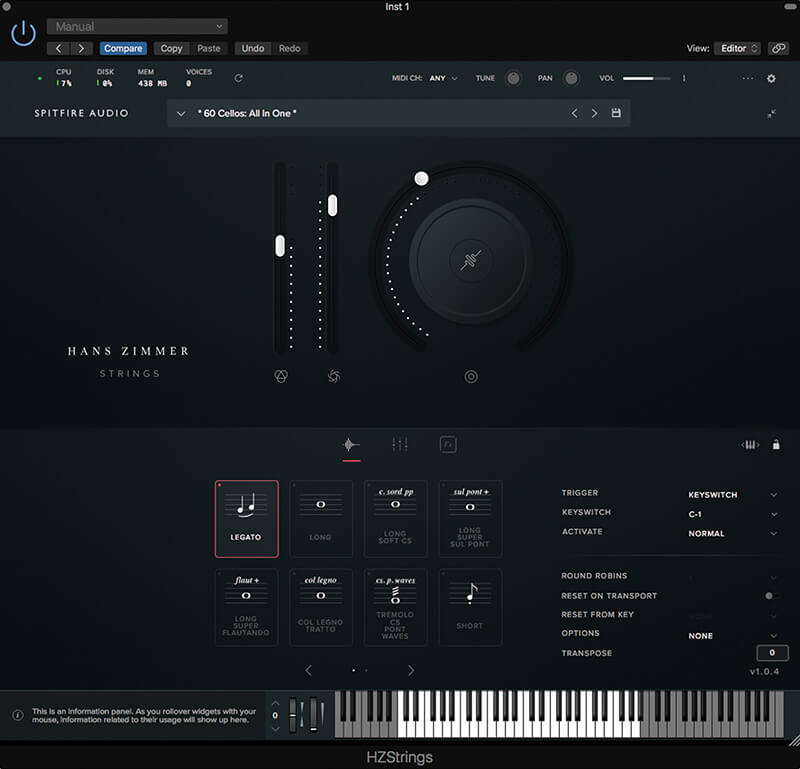
Working with the Violin patch, I added the Gallery mic’s into the timbre and sat back in wonder as the stereo image filled up beautifully, and I think that’s the real point of this library. There’s a space and air around the sound, which I haven’t heard elsewhere, achieved through the vast numbers of players, rather than just expansive ambience and reverberation. It’s also rather wonderful the way that the players blend together, forming a truly organic pad-like layer.
One area where this library will come into its own, is in the ability to break outside of the traditional Western orchestration mould. Because instruments have been recorded in so may stereo positions, it’s possible to do some fantastically creative orchestration by placing instruments in different locations, at least to the perceived ‘normal’ concert location.
This is a practice Zimmer uses himself, which works especially well in the cinematic auditorium, where the space can truly be exploited.
Working with two cello sections, close mic’d but on opposite sides of the spectrum, I was able to create a superbly interesting image, while the application of a little Ambient mic to the palette offered a beautiful, natural-sounding effect, and one that would just not be the same with the use of a straight panning control and reverberation.
So while there is an abundance of hushed tones, there doesn’t appear to be quite so much choice when it comes to the more epic timbre that you might immediately associate with Hans Zimmer.
Dynamic control
The straight long notes can sound pretty awesome under dynamic control, as I discovered with the doubling of octaves between the cellos and the basses, with the shorter articulations offering an immediacy of bite which I found exceptionally pleasing when adding room ambience and close mic’ing.
You can really hear the heel of the bow digging in, and with the slightly brighter orchestral colour thanks to a tad more High Frequency presence than might be the British norm, it does sound perfect for scoring work.
But despite all of this greatness of timbre, I do get a sense that the library slightly lacks the epic substance that you might expect with Hans Zimmer’s name attached to it. I was expecting to hear hugely bombastic patches, where all 344 players are going for it, hammer and tongs, and even at full-tilt with the more open timbre and articulation, this does not seem to be catered for.
Do I really need this?
Where HZ Strings scores really high is in the sheer scale and breadth of some of the sampling, but the forte of this seems to be far more in the area of subtlety, making it excellent for interesting string colours at the quieter end of the texture spectrum. It will swallow up the stereo image with ease.
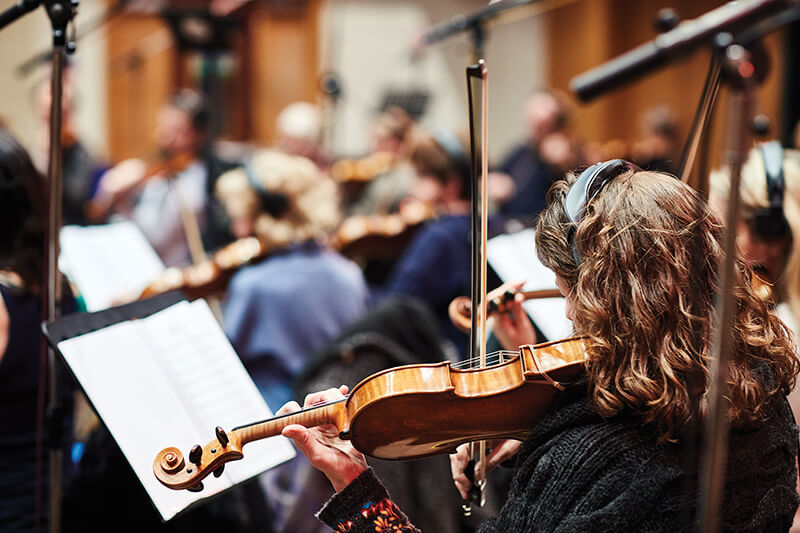
Short marcato articulations are available, which go someway to providing an epic palette, but when it comes to full-on long notes and ensemble patches, there will be more work for the user to do, probably alongside other sounds which may well be synthetic. As a stand-alone package, this is less appealing, but as part of a palette of cinematic timbre, it’s inspiring.
Lacklustre Legato
Certainly it can sound like a big string section, which you would like to hope would be the case, but it might also have something to do with the way that Zimmer works on his own projects, layering different live and synthetic timbres to achieve the overall result. It should be a consideration that this package should possibly be approached as just one element of a bigger, artistic picture.
An area that disappointed was the legato articulation, which I felt was still in need of development upon review. However we have it on good authority that optimising this further is a high-priority at Spitfire Towers.
At the time of our review we found legato to be quite glitchy, often freezing and then unravelling itself quickly. It is feasible that you can work with this on the programming level and by pre-delaying tracks you would find that the legato element would fall more into time, but this would only work with performances at slower tempo, as it couldn’t (at time of review) cope very well with speed.
This is a real shame, as the sonority of legato tone is absolutely stunning, so it’s a relief to hear that this will be (and hopefully, by time of publication, has been) fixed.
The final Tutti
This library has presented us with quite a few surprises; there is a plentiful supply of timbre which represent the quieter end of the sonic spectrum, and while we have seen these elsewhere, there is an extraordinary magic when you hear all 344 players playing together. This really works, as the collective melts together into a mass of bowed colour.
For pad-like orchestration, this library will sound amazing and prove exceptionally useful, as the breadth of imagery can soak up every aspect of the stereoscopic image, along with the frequency spectrum, but where I feel it is less assured is in the epic arena which, I think it is fair to say, most of us were expecting more bombast.
The longer tones do sound outstanding, and the assurance of gravitas that the thundering bottom end can offer is going to be a real boon for many users, but issues with the legato were disappointing.
It’s also important to understand that this library will need to be a single component in creating a Zimmer-esque score, rather than the be-all and end-all. With that understanding, and layering alongside other sounds, it will deliver.
I really love the creative possibilities that this package delivers, with the diversity of microphone placement, especially on the larger sections, but there is an inevitable swallowing of both RAM and CPU load, which could take a serious toll on a system the further down the microphone exploration rabbit hole you go.
Though this is a by-product of Spitfire really pushing the boat out with their innovative new ground-up development, and – we’re assured – will be rectified soon.
The inescapable point to make is that HZ Strings does sound very fine indeed – just perhaps not in all the ways that you might have been expecting. It’s a library that will need some investment from the user to get the best out of it and in many respects, this makes it a far more creative tool.
Alternatives
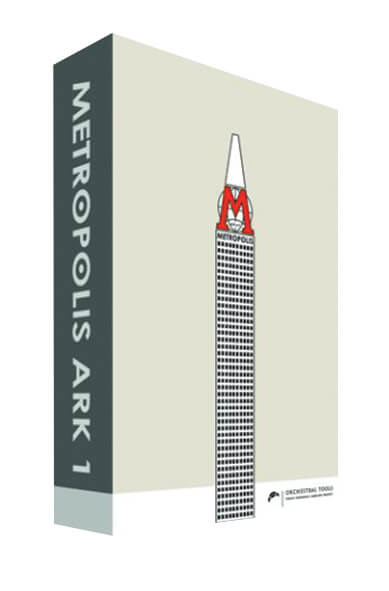
Orchestral Tools
Metrpolis Ark 1 �€549
No other library sums up bombastic to the same degree. Ark 1 features the most useable of all instrumental sections, complete with a choir singing Latin and a percussion section which is equipped to bring the house down. Don’t expect quiet!
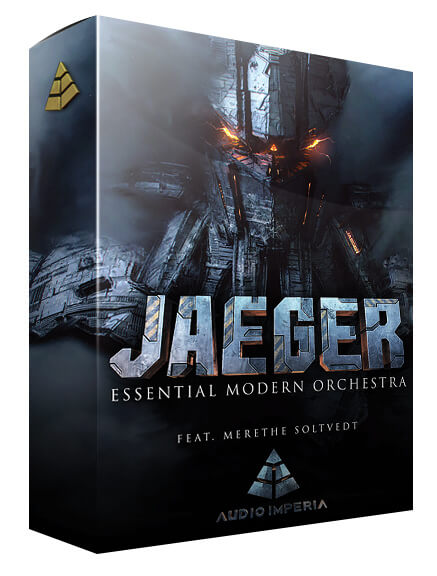
Audio Imperia
Jaeger Essential Modern Orchestra $599
This offers orchestral instrumentation for epic scoring, with highlights from the string section and solo vocal samples, performed by Merethe Soltvedt. There’s also a wealth of percussive content, alongside processed samples.